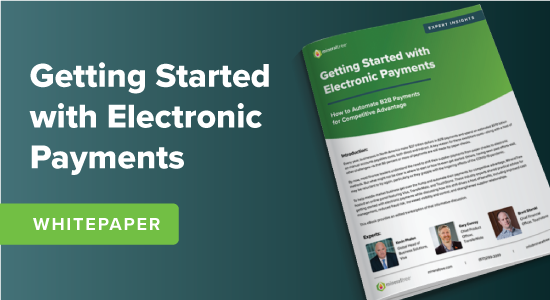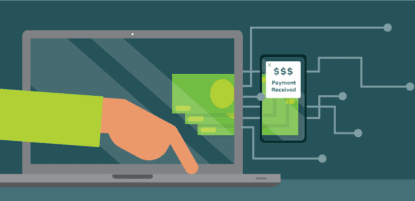What locks down and liberates your accounts payable process at the same time?
Here’s a hint: It travels in the form of a randomly generated credit card number that can only be charged one time for one specific amount. The answer, of course, is a virtual card; and the implications virtual card payments have on accounts payable teams are hard to ignore.
Virtual cards are raising the bar for what it means to securely process payments, and simultaneously creating new efficiencies and even revenue streams. Over 64% of CFOs plan on increasing their usage of virtual cards over the next year and 55% of finance leaders say that they are already using virtual cards more frequently.
While virtual cards are relatively new, they are not complex. On the contrary, transitioning to vendor payments with virtual cards is a simple process, and with the right AP automation provider, requires no additional effort or workflow change. Businesses that utilize virtual card payments will quickly realize the following benefits:
- Bolstered protection against fraud
- Faster payment processing
- Fits seamlessly into your workflow
- Easier payment reconciliation
- Cash-back rebates
What’s more, most vendors will gladly accept virtual cards in exchange for faster, secure, and assured payments, along with enhanced remittance information.
This article will explain how virtual cards are creating all of these benefits, but first, let’s review how virtual cards work.
What Are Virtual Cards?
Virtual cards are randomly generated 16-digit numbers that work like credit cards and are delivered for payment of goods and services. These credentials are generated through a process called tokenization, and can only be charged one time for a specified amount.
With MineralTree, there is no plastic CC # to protect, only tokenized numbers.With a traditional credit card payment, you are required to expose your credentials every time you make a payment. This information is often stored by vendors, and once stored, can easily fall into the wrong hands. Exposing this information to more vendors makes it more likely that credit card fraud will happen. With virtual cards, on the other hand, you never need to share your actual credit card information with anyone.
What Are Virtual Card Payments?
Virtual card payments are the process of paying a vendor for goods or services with an electronic payment option (ie. virtual cards) that does not require a physical credit card, cash, check, or another payment form. In fact, these payment forms don’t even exist with virtual card payments. Instead, virtual cards are completely digital, created with a pre-set amount indicated by the user to pay invoices at their exact amount. Once a virtual card payment has been made, it can be set up to expire if they aren’t charged within a designated time window.
How Do Virtual Card Payments Work?
Virtual card payments utilize a randomly generated 16-digit number sequence that works like a credit card, but is a completely digital payment. This means that there is no plastic credit card number to protect, and the virtual card can only be charged one time for a specified amount.
How Are Virtual Cards Changing Accounts Payable?
Virtual cards are changing accounts payable by offering businesses improved security, efficiency, reduced costs, and increased control throughout the entire payment process. In addition, virtual card payments allow businesses to take advantage of early-pay discounts, earn cash-back rebates, and reduce the amount of manual labor, which all contributes to improved cash flow. As a result of these benefits, virtual cards are becoming increasingly popular among businesses of all sizes.
How the Pandemic Became a Catalyst for the Rapid Shift to Virtual Card Payments
It’s no secret that the pandemic has affected how we do business. 58% of survey participants agree or strongly agree that the pandemic was the catalyst to digitizing the finance function. With the manual processes required to pay vendors in a timely manner, most professionals surveyed noted that AP was their top priority in terms of digitization.
In a webinar hosted by IOFM and sponsored by MineralTree, the President of Brousseau & Associates, Mark Brousseau spoke about the role of virtual cards in the accounts payable process. In this webinar, Mark discussed how companies were starting to make the transition to electronic payments (ePayments), but the progress was uneven across companies and within them. However, there was no sense of urgency to make the change. He stated that the pandemic forced everyone into a work from home environment where there was now an impetus to move forward with electronic payments in a more meaningful and faster-paced way than before.
ACH is a component of electronic payments. It is a payment method that has been around for a long time and one that companies are familiar with. However, when seeing the potential that virtual cards can offer, it makes sense to skip over, or “leap-frog” as Mike states, ACH wherever you can.
What Are the Benefits of Virtual Payment Cards in AP?
Virtual cards create improvements for all parties involved in accounts payable. Businesses that pay with virtual cards are improving their approach to B2B payments in a variety of ways.
1. Decrease Fraudulent Payments
Security is quite possibly the biggest benefit when it comes to virtual card payments. As fraudulent payments continue to rise, it is important that businesses implement secure online payment practices. Virtual card payments are secure by nature since there is no physical item to steal and no credit card number to clone. They also eliminate the risk of vendors re-using your business’ credit card information by accident or for unforeseen charges. Since virtual cards expire once the indicated dollar amount has been transferred to the end recipient, the risks for fraud or theft are eliminated, making them the safest online payment option.
2. Optimize Working Capital
In a B2B payments world that is still dominated by paper checks, virtual cards are enabling a more strategic approach. While paper checks require several days to print, pack, postmark, and mail to vendors, virtual card payments can be executed instantly. The ability to pay faster enables teams to hang on to large payment sums for more time and collect more returns on them as working capital. Faster payments also translate to more on-time payments, strengthening your relationship with a key stakeholder in your business: your suppliers.
3. Companies Earn Cash-Back Rebates on Every Payment
This point is a matter of simple math. You’re making payments to your vendors anyway, so why not earn cash-back rebates on your payments? It’s free money that requires almost no effort to earn. Take, for example, Quartzy: They’re tracking to earn $100,000 in rebates by using MineralTree’s SilverPay virtual card, and the rebates they’re earning well exceed the cost of the MineralTree platform itself. As your business – and list of vendors – continues to grow, your rebate total will grow too and start adding up to a tidy sum to be reinvested into your business.
See how Attivio transitioned to virtual card payments to earn rebates>>
4. AP Teams Provide a Streamlined Supplier Experience
When comparing ACH and paper checks to virtual cards, virtual cards offer numerous advantages. As a result, virtual card adoption has grown significantly over the past few years. With this growth, suppliers have also realized the many hidden benefits of virtual cards, namely faster payments, assurance of funds, and enhanced remittance. The Accounts Receivable teams at your suppliers will also appreciate the time savings and convenience of virtual cards compared to the onerous and manual workflows of processing checks. Virtual cards also make it easier to track invoice payments, resulting in more visibility throughout the payment process.
5. AP Teams Save Costs and Reduce Manual Processes
Something that accounts payable and accounts receivable teams can agree on wholeheartedly is that paper is no fun to process. Printing, signing, packing, postmarking, and mailing checks is arguably the most tedious and painful component of the accounts payable process. Likewise, tearing open envelopes, endorsing, and depositing dozens of checks at a time could be considered even worse. Paying with virtual cards makes life better for your accounts payable team and the teams that you’re paying by creating new efficiency. Additionally, virtual card payments liberate both teams to focus on more engaging and interesting work that can move the business forward, rather than simply maintain the status quo.
According to a study done by IOFM, 91% of AP departments are working at home at least in-part, and this shift to remote working has posed operational challenges and risks. Many companies are switching to a hybrid working environment or now have fully remote teams. Reducing manual processes can help AP departments who have made this switch.
6. Virtual Cards Improve Payment Accuracy
Duplicate payments can easily occur for busy AP teams. Vendors may mail a hard copy of an invoice and attach it via email as a reminder. By utilizing virtual cards, your team can assign amounts to suppliers prior based on the already established agreements.
7. Virtual Cards Lead to Easier Payments
Say goodbye to passing around a company credit card! Simply put, virtual card payments provide the convenience that every accounts payable department needs by being easy to create and send to vendors. No more misplaced cards, slow processing times, or suspicious charges made to your account. The online element of virtual cards makes payments pain-free and more efficient than traditional credit cards, while also protecting sensitive information with each transaction.
8. Suppliers Like Virtual Cards
Virtual cards and electronic payments were being adopted before the pandemic for the benefits that they provide over paper checks. Specifically, virtual cards cost less, are less risky, suppliers like them, and they settle faster. Virtual card payments can be deposited into a suppliers’ account much faster than paper checks, arrive with remittance data, they are traceable, cannot be intercepted or white-washed like paper checks, and they can arrive in the suppliers account on time. These are all key reasons why suppliers are much more likely to accept virtual cards now.
9. Embrace a Paperless AP Process
Virtual cards are a great step in creating a paperless accounts payable process. For offices that either have become remote or hybrid during the pandemic, digital payments have made it easier to facilitate payment to vendors. With virtual cards, payments can be made anywhere, reducing bottlenecks in your AP workflow.
The Rapid Shift to Virtual Cards in AP
From the perspective of an accounts payable team, there are significant advantages to leveraging a virtual card through an AP automation platform. With separate cards, AP teams have to spend a lot of time reconciling separate credit card statements. Additionally, companies using virtual cards earn 0.5% cash-back. For every million dollars processed, organizations earn $5,000 back.
Quartzy, a leading life science product distributor, provides the ability to order 10 million products from more than 1,800 leading brands. They sell products to over 425,000 scientists in labs and research groups. The high volume nature of their business created challenges for AP teams. 100 invoices may need to be processed at a given time, with many vendors looking for payment status.
Quartzy decided to partner with MineralTree, shifting to an end-to-end AP automation solution. MineralTree’s virtual card, SilverPay, has also allowed the company to earn significant cash back, with a projected $100,000 in cash back rebates by the end of this year. Additionally, since SilverPay is part of the MineralTree platform, this virtual card enables fully automated invoice payments and seamless reconciliation. By switching to AP automation, Quartzy was able to improve supplier relationships, reduce risk from invalid invoices, and improve efficiency.
The Business Case for Virtual Cards
Studies show that it costs about $5.95 to pay a supplier with a paper check from beginning to end. In the remote working environment, there isn’t time to deal with all the manual steps involved in this process. Credit card companies, like American Express, Visa and Mastercard, are making moves to drive more B2B vendor payments to cards. Recognizing an opportunity for organizations to support initiatives to transition away from paper check and reap the benefits of card payments such as rebates, rewards and cashback, these companies are focusing on accounts payable software and areas to integrate.
As noted above, there are many advantages to using virtual cards. For AP departments, paying suppliers electronically frees up staff to focus on tasks that will add more value to the business such as data analysis and supplier management, things that will help a business return to growth. Virtual cards help AP departments do more with less. They help modernize their processes, and they deliver both departmental benefits and provide a payoff for the entire business as well as suppliers. In addition, giving vendors your actual card details is a gateway to fraud and virtual cards overcome this while still allowing companies to gain the benefits of card payments.
The Best Way to Get Started with Virtual Card Payments
Paying with a virtual card is very similar to the process of paying with a traditional credit card. However, attempting to manage either process on your own will leave many opportunities for greater efficiency on the table. To pay with any card, businesses have needed to utilize a distinct login credential with their credit card issuer, and then go through a set of steps within that portal to get credit card payments out the door. Accounts payable automation platforms simplify all of this down to just a few clicks.
MineralTree’s accounts payable automation platform and SilverPay virtual cards streamline payments by centralizing the AP process into one cohesive workflow. With AP automation, the entire process, from the time you receive an invoice to the time you pay that invoice, is accelerated by cutting manual intervention out every possible step. This includes the steps for capturing data on vendor invoices, securing invoice approvals from department heads, getting payment authorizations executives, and executing the payments.
In addition, MineralTree helps with virtual card adoption by providing continuous enrollment campaigns, vendor inquiry support, ProxyPay and additional Payment Services available in Standard and Premier packages. This means that MineralTree can help execute transactions on your behalf for vendors that accept payment via phone or online portal — which accounts for more than 25% of an average customer’s virtual card spend.
By choosing SilverPay virtual card, organizations can take advantage of a payment method that is faster than ACH, more secure than check, and that fits seamlessly into their current workflows. With an implementation process of just a few days, AP automation offers the most viable path to building virtual card payments into your business’ accounts payable department.
Curious to see what your business can look like with virtual card payments and AP automation? Contact MineralTree to schedule a personalized demo.
Virtual Card Payments FAQs
How Does Virtual Pay Work?
Virtual pay with a virtual card works like any other digital payment method, but is a single use payment solution. It uses a randomly generated 16-digit number that can only be charged one time for a specified amount.
Is Virtual Card Debit or Credit?
A virtual card works like a credit card, but is a completely digital payment and its randomly generated 16-digit number can only be used once – unlike traditional credit or debit cards.
What Are the Benefits of Virtual Cards?
Virtual cards offer a number of benefits including enhanced security, reduced fraudulent payments, improved internal controls and payment accuracy, and optimized working capital.
Can you use Virtual Cards to Pay Online?
Yes! Virtual card payments are an electronic payment form and can only be made online. Although they are very similar to physical credit cards, virtual cards are completely digital and can only be used one time, for a specific amount indicated prior to creating the virtual card.
What Are the Benefits of Virtual Card Payments?
Virtual card payments are improving the way businesses approach to B2B payments in a variety of ways, including:
- Decreased fraudulent payments
- Ability for AP Teams to cut costs and reduce manual processes
- Optimize working and spending capital
- Virtual cards improve payment accuracy
- AP Teams provide a streamlined supplier experience with enhanced visibility into the AP payment process.
- Companies earn cash-back rebates on every payment
- Virtual cards lead to easier, more streamlined payments
- Suppliers prefer virtual cards






